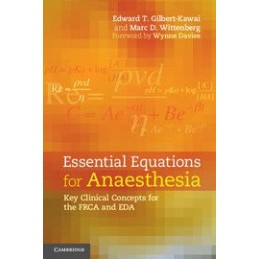Opis
A sound knowledge of equations and their use, derivation and clinical application is an absolute prerequisite for any anaesthetist. As a result, equations are a favourite question topic of examiners, particularly in the viva examinations. Many candidates answer these poorly, losing valuable marks and floundering when they face what they perceive as nightmare questions. This book provides a simple, portable, reference guide to all the equations that candidates may be asked about during their examinations. The content is split into four sections:: physics, pharmacology, physiology and statistics. Each equation is clearly explained, derived where necessary, and placed into a clinical context using a worked or clinically relevant example to demonstrate its use. Units and relevant terms are given and, where required, clear, concise diagrams have also been provided to simplify understanding. Written by anaesthetic trainees, this is an essential resource for preparation for the FRCA, EDA and other anaesthetic examinations.
Szczegóły produktu
Indeks
66806
EAN13
9781107636606
ISBN
9781107636606
Opis
Rok wydania
2014
Numer wydania
1
Oprawa
miękka foliowana
Liczba stron
218
Wymiary (mm)
156.00 x 234.00
Waga (g)
310
Preface; Foreword; Part I. Physics:: Section 1A. Gases:: 1. Boyles law; 2. Charles law; 3. Gay-Lussacs law; 4. Avogadros law; 5. Universal gas equation; 6. Daltons law of partial pressures; 7. Henrys law; 8. Grahams law of diffusion; Section 1B. Pressure and Flow:: 1. Pressure and force; 2. Hagen-Poiseuille equation and laminar flow; 3. Reynolds number and turbulent flow; 4. Laplaces law and tension; 5. Bernoulli equation and Venturi effect; Section 1C. Electricity:: 1. Ohms law:: voltage, current and resistance; 2. Capacitance; 3. Inductance; 4. Work and power; 5. Transformers; 6. Electrical charge; Section 1D. Other:: 1. Doppler equation and Doppler effect; 2. Beer-Lambert law; 3. Humidity; 4. Natural frequency; 5. Wave equation and ultrasound; Part II. Pharmacology:: Section 2A. Pharmacokinetics:: 1. Bioavailability; 2. Volume of distribution; 3. Clearance; 4. Hepatic clearance; 5. Concentration and elimination; 6. Plasma concentration and compartment models; 7. Loading dose and maintenance dose; 8. Exponential function and rate constant; 9. Half life and context-sensitive half life; 10. Time constant; 11. Rates of reaction; 12. Michaelis-Menten equation; Section 2B. Pharmacodynamics:: 1. Drug-receptor dissociation constant and affinity; 2. Therapeutic index; Part III. Physiology:: Section 3A. Cardiovascular:: 1. Cardiac output and cardiac index; 2. Stroke volume; 3. Ventricular stroke work and index; 4. Ejection fraction and fractional area change; 5. Coronary perfusion pressure and coronary blood flow; 6. Bazetts formula - QT interval corrected; 7. The Fick principle - cardiac output measurement; 8. The Fick equation - oxygen uptake measurement; 9. Mean arterial pressure; 10. Venous return; 11. Total blood volume; 12. Systemic vascular resistance; 13. Uterine blood flow; 14. Stewart-Hamilton equation; 15. Oxygen delivery; 16. Oxygen extraction ratio; 17. Oxygen content; 18. The dilution principle - measurement of fluid compartment volume; Section 3B. Respiratory:: 1. Diffusing capacity; 2. Compliance; 3. Bohr equation; 4. Alveolar ventilation equation; 5. Alveolar gas equation; 6. Helium dilution technique; 7. Spirometry:: forced expiration; 8. Lung volumes and capacities; 9. Respiratory quotient (and respiratory exchange ratio); 10. Shunt equation; 11. Pulmonary vascular resistance; Section 3C. Renal:: 1. Renal filtration fraction; 2. Renal clearance and Cockcroft-Gault formula; 3. Starlings equation - rate of filtration; 4. Ficks law of diffusion; Section 3D. Cellular, Biochemical and Acid-base:: 1. Osmolality, osmolarity and the osmolar gap; 2. Morse equation and osmotic pressure; 3. Anion gap; 4. Goldman equation; 5. Gibbs-Donnan effect; 6. Nernst equation; 7. pH; 8. pKa; 9. Acid-base compensation simplified; 10. Henderson-Hasselbalch equation; Section 3E. Neurological:: 1. Cerebral perfusion pressure and intracranial pressure; 2. Intraocular pressure; Part IV. Statistics:: 1. Binary classification tests and 2x2 tables; 2. Negative predictive value; 3. Positive predictive value; 4. Specificity; 5. Sensitivity; 6. Relative risk; 7. Relative risk reduction; 8. Absolute risk reduction; 9. Accuracy of test; 10. Chi-squared test; 11. Likelihood ratio; 12. Standard error of mean; 13. Standard deviation and variance; 14. Power; 15. Odds ratio; Appendix:: 1. The international system of units; 2. Units of measurement; Index.


 Dostawa
Dostawa
 Płatność
Płatność
 Zwroty
Zwroty
